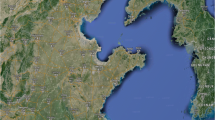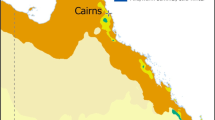Abstract
The extent of the association between temperature and heat-coded deaths, for which heat is the primary cause of death, remains largely unknown. We explored the association between temperature and heat-coded deaths and potential interactions with various demographic and environmental factors. A total of 335 heat-coded deaths that occurred in Oklahoma from 1990 through 2011 were identified using heat-related International Classification of Diseases codes, cause-of-death nomenclature, and narrative descriptions. Conditional logistic regression models examined the association between temperature and heat index on heat-coded deaths. Interaction by demographic factors (age, sex, marital status, living alone, outdoor/heavy labor occupations) and environmental factors (ozone, PM10, PM2.5) was also explored. Temperatures ≥99 °F (the median value) were associated with approximately five times higher odds of a heat-coded death as compared to temperatures <99 °F (adjusted OR = 4.9, 95% CI 3.3, 7.2). The effect estimates were attenuated when exposure to heat was characterized by heat index. The interaction results suggest that effect of temperature on heat-coded deaths may depend on sex and occupation. For example, the odds of a heat-coded death among outdoor/heavy labor workers exposed to temperatures ≥99 °F was greater than expected based on the sum of the individual effects (observed OR = 14.0, 95% CI 2.7, 72.0; expected OR = 4.1 [2.8 + 2.3–1.0]). Our results highlight the extent of the association between temperature and heat-coded deaths and emphasize the need for a comprehensive, multisource definition of heat-coded deaths. Furthermore, based on the interaction results, we recommend that states implement or expand heat safety programs to protect vulnerable subpopulations, such as outdoor workers.
Similar content being viewed by others
References
Analitis A, Michelozzi P, D'Ippoliti D, De'Donato F, Menne B, Matthies F, Atkinson RW, Iniguez C, Basagana X, Schneider A, Lefranc A, Paldy A, Bisanti L, Katsouyanni K (2014) Effects of heat waves on mortality: effect modification and confounding by air pollutants. Epidemiology (Cambridge, Mass) 25(1):15–22. doi:10.1097/EDE.0b013e31828ac01b
Anderson BG, Bell ML (2009) Weather-related mortality: how heat, cold, and heat waves affect mortality in the United States. Epidemiology (Cambridge, Mass) 20(2):205–213. doi:10.1097/EDE.0b013e318190ee08
Arbury S, Jacklitsch B, Farquah O, Hodgson M, Lamson G, Martin H, Profitt A (2014) Heat illness and death among workers—United States, 2012–2013. MMWR Morb Mortal Wkly Rep 63(31):661–665
Barnett AG, Tong S, Clements AC (2010) What measure of temperature is the best predictor of mortality? Environ Res 110(6):604–611. doi:10.1016/j.envres.2010.05.006
Basu R, Feng WY, Ostro BD (2008) Characterizing temperature and mortality in nine California counties. Epidemiology (Cambridge, Mass) 19(1):138–145. doi:10.1097/EDE.0b013e31815c1da7
Basu R, Samet JM (2002) Relation between elevated ambient temperature and mortality: a review of the epidemiologic evidence. Epidemiol Rev 24(2):190–202
Berko J, Ingram DD, Saha S, Parker JD (2014) Deaths attributed to heat, cold, and other weather events in the United States, 2006–2010. Natl Health Stat Report 76:1–15
Braga AL, Zanobetti A, Schwartz J (2002) The effect of weather on respiratory and cardiovascular deaths in 12 U.S. cities. Environ Health Perspect 110(9):859–863
Epidemiologists CoSaT (2016) Heat-related illness syndrome query: a guidance document for implementing heat-related illness syndromic surveillance in public health practice.
Filleul L, Cassadou S, Medina S, Fabres P, Lefranc A, Eilstein D, Le Tertre A, Pascal L, Chardon B, Blanchard M, Declercq C, Jusot JF, Prouvost H, Ledrans M (2006) The relation between temperature, ozone, and mortality in nine French cities during the heat wave of 2003. Environ Health Perspect 114(9):1344–1347
Gasparrini A, Guo Y, Hashizume M, Lavigne E, Zanobetti A, Schwartz J, Tobias A, Tong S, Rocklöv J, Forsberg B, Leone M, De Sario M, Bell ML, Guo YLL, Wu C-F, Kan H, Yi S-M, de Sousa Zanotti Stagliorio Coelho M, Saldiva PHN, Honda Y, Kim H, Armstrong B (2015) Mortality risk attributable to high and low ambient temperature: a multicountry observational study. Lancet 386(9991):369–375. doi:10.1016/S0140-6736(14)62114-0
Gubernot DM, Anderson GB, Hunting KL (2015) Characterizing occupational heat-related mortality in the United States, 2000–2010: an analysis using the census of fatal occupational injuries database. Am J Ind Med 58(2):203–211. doi:10.1002/ajim.22381
Harduar Morano L, Watkins S, Kintziger K (2016) A comprehensive evaluation of the burden of heat-related illness and death within the Florida population. Int J Environ Res Public Health 13(6):551
Harlan SL, Declet-Barreto JH, Stefanov WL, Petitti DB (2013) Neighborhood effects on heat deaths: social and environmental predictors of vulnerability in Maricopa County, Arizona. Environ Health Perspect 121(2):197–204. doi:10.1289/ehp.1104625
Jackson LL, Rosenberg HR (2010) Preventing heat-related illness among agricultural workers. J Agromedicine 15(3):200–215. doi:10.1080/1059924x.2010.487021
Janes H, Sheppard L, Lumley T (2005) Case-crossover analyses of air pollution exposure data: referent selection strategies and their implications for bias. Epidemiology (Cambridge, Mass) 16(6):717–726
Johnson MG, Brown S, Archer P, Wendelboe A, Magzamen S, Bradley KK (2016) Identifying heat-related deaths by using medical examiner and vital statistics data: surveillance analysis and descriptive epidemiology—Oklahoma, 1990–2011. Environ Res 150:30–37. doi:10.1016/j.envres.2016.05.035
Knol MJ, VanderWeele TJ (2012) Recommendations for presenting analyses of effect modification and interaction. Int J Epidemiol 41(2):514–520. doi:10.1093/ije/dyr218
Li Y, Ma Z, Zheng C, Shang Y (2015) Ambient temperature enhanced acute cardiovascular-respiratory mortality effects of PM2.5 in Beijing, China. Int J Biometeorol 59(12):1761–1770. doi:10.1007/s00484-015-0984-z
Lin M, Stieb DM, Chen Y (2005) Coarse particulate matter and hospitalization for respiratory infections in children younger than 15 years in Toronto: a case-crossover analysis. Pediatrics 116(2):e235–e240. doi:10.1542/peds.2004-2012
Mesonet O (2017) Quality assurance. https://www.mesonet.org/index.php/quality_assurance. Accessed 6 March, 2017
Metzger KB, Ito K, Matte TD (2010) Summer heat and mortality in New York City: how hot is too hot? Environ Health Perspect 118(1):80–86. doi:10.1289/ehp.0900906
National Weather Service (2014) The heat index equation. http://www.wpc.ncep.noaa.gov/html/heatindex_equation.shtml. Accessed March 6, 2017
Petitti DB, Harlan SL, Chowell-Puente G, Ruddell D (2013) Occupation and environmental heat-associated deaths in Maricopa County, Arizona: a case-control study. PLoS One 8(5):e62596. doi:10.1371/journal.pone.0062596
Petitti DB, Hondula DM, Yang S, Harlan SL, Chowell G (2016) Multiple trigger points for quantifying heat-health impacts: new evidence from a hot climate. Environ Health Perspect 124(2):176–183. doi:10.1289/ehp.1409119
Ren C, Williams GM, Morawska L, Mengersen K, Tong S (2008) Ozone modifies associations between temperature and cardiovascular mortality: analysis of the NMMAPS data. Occup Environ Med 65(4):255–260. doi:10.1136/oem.2007.033878
Ren C, Williams GM, Tong S (2006) Does particulate matter modify the association between temperature and cardiorespiratory diseases? Environ Health Perspect 114(11):1690–1696. doi:10.1289/ehp.9266
Semenza JC, Rubin CH, Falter KH, Selanikio JD, Flanders WD, Howe HL, Wilhelm JL (1996) Heat-related deaths during the July 1995 heat wave in Chicago. N Engl J Med 335(2):84–90. doi:10.1056/nejm199607113350203
Survey OC (2016) Climate of Oklahoma.
Whitman S, Good G, Donoghue ER, Benbow N, Shou W, Mou S (1997) Mortality in Chicago attributed to the July 1995 heat wave. Am J Public Health 87(9):1515–1518
Zanobetti A, Schwartz J (2008) Temperature and mortality in nine US cities. Epidemiology (Cambridge, Mass) 19(4):563–570. doi:10.1097/EDE.0b013e31816d652d
Zou GY (2008) On the estimation of additive interaction by use of the four-by-two table and beyond. Am J Epidemiol 168(2):212–224. doi:10.1093/aje/kwn104
Author information
Authors and Affiliations
Corresponding author
Ethics declarations
Conflict of interest
The authors declare that they have no conflict of interest.
Financial disclosure
The authors have no financial relationships relevant to this article to disclose.
Electronic supplementary material
ESM 1
(DOCX 96 kb)
Rights and permissions
About this article
Cite this article
Moore, B.F., Brooke Anderson, G., Johnson, M.G. et al. Case-crossover analysis of heat-coded deaths and vulnerable subpopulations: Oklahoma, 1990–2011. Int J Biometeorol 61, 1973–1981 (2017). https://doi.org/10.1007/s00484-017-1387-0
Received:
Revised:
Accepted:
Published:
Issue Date:
DOI: https://doi.org/10.1007/s00484-017-1387-0




